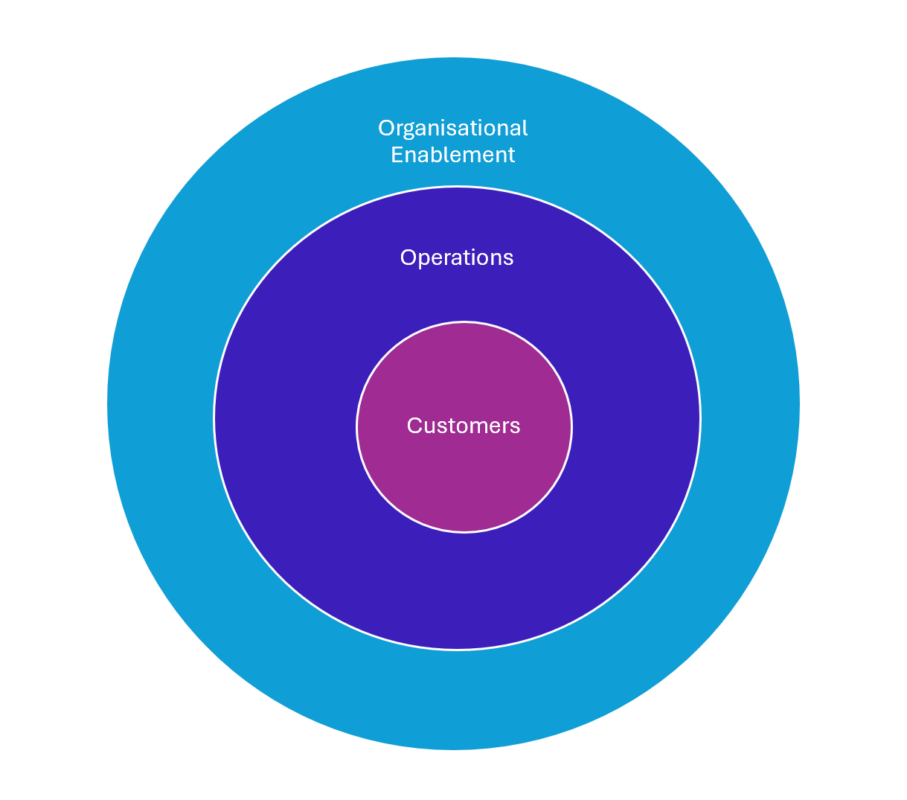A seasoned HR leader outlines why having HR responsible for multiple aspects of the work ecosystem benefits an organisation, and how her organisation is doing just that.
I have worked in various HR leadership positions in different industries over the course of my 25-year career, but it wasn’t until I joined my current employer, EACH, that I had an opportunity to expand my remit to include more than HR tasks.
EACH is a large, complex community health organisation that runs over 150 different programs across six different program streams: mental health, older adults, NDIS, early childhood, primary care and child, youth and family services. I spent the first four years at EACH leading the organisation’s HR function, but when our CEO, Natalie Sullivan, restructured the executive team, she decided to put all support functions under one leadership role.
Under the old leadership structure, the back-office function consisted of a Corporate Services Director, who was responsible for IT, finance and infrastructure, a Strategy Development and Marketing Director, and an HR Director (my former role). There were also two Directors of Operations to manage the front-end functions of the business.
While this structure previously served us well, as the organisation became more complex over time, we found it was introducing inefficiencies. From the perspective of the back-office support functions, we often struggled to have alignment between the three business units; we were all working towards our own KPIs and strategic plans.
This lack of alignment was having an impact on the people who were delivering front line services to clients and, in some instances, making things more difficult for them.
For example, we might have previously had HR rolling out a training program at the same time finance required managers to work on budget-related tasks and IT was implementing a new system.
In a for-purpose organisation, funding is lean and the expectations on our operations teams to deliver to the KPIs of the funding contracts means the majority of their time is providing services to clients.
It’s essential that the back-office support teams that are there to support Operations are not making their jobs harder.
Recognising that the structure was ineffective and inefficient, Natalie made the decision to consolidate responsibility for the back and front-end operations at EACH to sit under two executives, an Executive Director Operations and an Executive Director Organisational Enablement, which is my current role.
The decision to call ourselves the ‘organisational enablement’ team was very intentional because that was the required shift in how we viewed our back-office function: we exist to enable the business to do great work.
We saw the Operations teams as the core, as they are providing essential services to our customers, and the Operations Enablement Team wraps around them to enable them to do that.

No need to be a technical expert
While my remit now expands to include HR, finance, infrastructure, quality and risk, the national intake service, as well as IT, other than the HR remit, I am by no means a technical expert in each area.
Instead, it’s the ways of thinking and my people-centric lens garnered through my years in HR that enable me to make a unique contribution as an executive leader. Pragmatism and a strong dose of common sense certainly helps too!
For example, since having responsibility for IT, I’ve restructured the team, engaging external support to provide advice on the technical aspects.
I worked with the new IT leadership team to develop a five-year IT roadmap. I’ve been able to contribute skills in translating ‘what needs to be done’ into a strategic plan that justifies the resources required to deliver.
Not having an IT background can have its benefits, as I had to ask a lot of questions to understand what was needed, and that enabled a roadmap and communications strategy that has been translated into language everyone can understand and relate to.
We have exceptional talent in our IT team. They know what they need to do, but just require support to be enabled to do it. This means I didn’t immediately put a Chief Information Officer into the structure, as I wanted to see how it worked with the IT leaders collaboratively leading among themselves.
After six months of working closely with them, I determined there wasn’t a significant gap. The gap that was evident was my lack of technical knowledge, meaning if they needed someone to bounce technical ideas off, I wasn’t particularly helpful.
To mitigate that gap, we have engaged a fractional CIO to support the team when they need it, provide advice to me and to have external oversight to our IT roadmap and strategy, which gives the board reassurance that we’re on the right track.
The most critical skills are the ability to listen, bring together different people and perspectives to work collaboratively together and recognise when you’ve got something wrong and need to adapt. My general approach is to put out what is proposed and ask people to tell me what’s wrong with it or what’s missing. If you listen to their responses, you can make better decisions.
Spreading the word
While I don’t have responsibility for our communications or marketing units, the work of these teams does inform a lot of my role in organisational enablement.
For example, a recent project I’ve worked on with this team is working out how we can make the work of the organisational enablement teams more visible to the rest of the business.
“We have to demonstrate our ability to see the bigger picture and align with the broader business goals. I wouldn’t be in my position today had I not done that.” – Clare Murphy FCPHR
There’s often a tension between what these teams are asked to do and what they have the capacity to deliver on; they can be pulled in a variety of directions.
I also work very closely with our Executive Director Operations, Camilla Radia-George, to address these tensions; the relationship with her is critical. When there are competing priorities, we get together to map out the priorities to make sure we’re aligned and are continuing to work towards the same goals.
To create that visibility and transparency, one of the things we have been doing is creating a series of short videos that interview some of our back-office employees about what they’re working on.
We found that this resulted in increased understanding of the demands of the back-of-house teams – like Operations, they have competing demands and by making this visible to the broader team, people are more patient with requests and willing to be flexible with time frames.
As an executive leader, a key part of my job is tying all the threads together and getting teams to see how their effort and time contributes not only to our customers, but also to their fellow teammates. Having a bird’s-eye view of each function makes that much easier to do.
I often say to our leaders, ‘That will impact X team. Have you looped them into this work?’ or ‘We may have to push that time frame back, as X is happening and that will impact staff too.’
The future role of HR
I would love to see organisations moving away from the common move of having the Chief Financial Officer as the next in line for a CEO position. Organisations can benefit immensely from having more HR leaders in executive leadership roles and taking on a broader remit.
Our ability to navigate complexity, manage stakeholders of all levels in the organisation and apply a people-focused lens to decision-making means we’re able to make unique contributions to the business.
But we also have to demonstrate our ability to see the bigger picture and align with the broader business goals. I wouldn’t be in my position today had I not done that.
If you are wanting to move into a broader role, don’t wait to be asked. Get involved in projects outside HR, speak to your CEO about your intentions and see what opportunities are available. For example, you could ask your colleagues in finance or IT if you can join meetings with them to learn about their priorities and ways of working.
To become a future-ready HR leader, it’s about more than just having technical aptitude and understanding how to read a financial report. It’s about how you support people to work in more effective ways – enabling them to make impactful contributions to the business and having a return on investment in the process.
Want to learn more about how to develop executive presence to enhance your HR leadership? Sign up for AHRI’s webinar on this topic on 1st of May. Free for AHRI members.


Well done Clare! I am not surprised that you have taken both a big picture and a specifics view of the enterprise and capitalised on your wealth of experience over several different roles – well done! EACH must be very grateful to have you on board!
Great read.